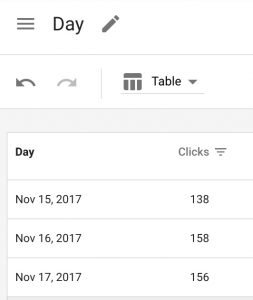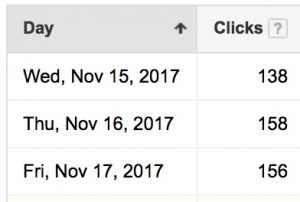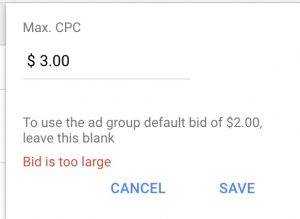As has become our tradition at this time of year, we like to compile a wish list of the things we’d love to see in paid search in the new year.
Do we make this annual wish list because all our wishes come true? Sadly, no. But we haven’t given up hope that things will be different this year. (And we’re secretly hoping that Google someone will see our list and recognize the brilliancy of our ideas.)
So now, without further delay, here’s our wish list for 2018!

Wish #1: Speed up the transition to the new AdWords user interface
With a few minor quibbles, we’re actually big fans of the new AdWords user interface. But we wish the transition would happen faster. Having one foot in the new interface, and one foot in the old, is confusing, especially for new users.
For example, we recently brought a new staff member onboard (welcome, Lexi!). At the outset, we decided to train her primarily in the new user interface. Because what’s the point in training her in the old interface when it will eventually be discontinued?
But here’s the problem: Not every function is available in the new interface. Which means that poor Lexi ends up having to learn two interfaces at the same time.
What functions are we talking about? Mostly, they’re minor things. For instance, when using day segmentation in the dimensions tab, the new UI gives only the month, date and year:

Days in dimensions tab—new user interface
But the old user interface also provides the day of the week, which is a useful detail!

Days in dimensions tab—old user interface
As a result, we end up flipping back and forth between interfaces.
The good news is that Lexi reports finding the new interface more intuitive and easier to use than the old. Which is reassuring!
Wish #2: Revise Google ad grant parameters
Google provides free online advertising to nonprofits under its Google Ad Grants program. In theory, this is a great initiative. But in practice, it falls short—especially in recent years.
The program offers nonprofits up to $10,000 in ad spending per month. Which sounds very generous. But we’ve found that actually spending this amount is almost impossible. Typically, we find that our Google Ad Grants clients only manage to spend about $800 to $1500 per month!
Part of the problem lies in the program’s $2.00 bid limit. Here’s what happens when you try to exceed it:

The $2.00 bid limit has been in place since January 2013. But we’ve seen significant increases in cost per clicks since then. So isn’t it time to increase the bid limit ceiling as well?
For example, one of our nonprofit clients provides support services to cancer patients and their families. Inevitably, their ads end up competing with those of prescription drug companies. Staying within that $2.00 bid limit—and getting your ads to impression—isn’t easy.
A little more latitude here would be welcome.
Wish #3: Stop substituting automation for precision
Google wants to make things easier for novice AdWords users. We get that. But please, don’t force experienced users to give up precision and control to make that happen. Can’t we have both?
We see this favoring of automation over precision most often in (1) automated call extensions, (2) dynamic structured snippet extensions and (3) ad suggestions.
1. Automated call extensions
From the AdWords help file:
When your website indicates that your business goals include getting people to call you, AdWords may set up automated call extensions. On mobile, people can click your extension to call your business.
Basically, Google creates automated call extensions by scraping client sites and adding any phone number they can find to client ads. No, thank you!
Most of our clients use different phone numbers for different purposes. For example, they’ll have different numbers for different sales regions. Or they’ll have different numbers for different types of sales.
Automating the collecting and inserting of phone numbers makes it highly likely that the wrong phone number will end up in the wrong ad. Not good.
2. Dynamic structured snippet extensions
Again from the AdWords help file:
When [dynamic structured snippet extensions] might show with your ads
Your ads may show dynamic structured snippets automatically when your ad is eligible and your landing page has a matching category for a search.
Again, no thank you. We work diligently and closely with our clients to craft messaging for client ads and all their extensions. We pour over every word and consider each ad in the context of each clients’ goals.
How could an automated process possibly compare?
3. Ad suggestions
Google has been testing the automatic creation of ads in some accounts for the past year or so.
The AdWords help file describes how the ads are generated:
…a combination of human review and machine learning is used to create high-quality ad suggestions. Relevant content from your account used to create ad suggestions include your existing ads, extensions, and landing page. Google also uses additional signals such as keywords and targeting in order to optimize the ad copy.
Some of these auto-ads have appeared in our client accounts. So far, we haven’t used any. The ads simply didn’t look as buttoned-up as we want. And many didn’t quite fit with our clients’ objectives.
We’re keeping an open mind about auto-ads. But at the same time, how realistic it is for Google to understand the many nuances of our clients’ businesses?
And I have one more concern: Google only gives advertisers 14 days to review and release ads to accounts for use. But 14 days is rather short. Usually, we like to run these ads by our clients, and sometimes it can take a week to get them on the phone—never mind secure necessary approvals.
Wish #4: Go further with category exclusions for hate, extremist views and fake news
Earlier this year, some of our clients became concerned about where their ads are appearing. They wanted to make sure that their ads weren’t showing up on sites sporting hate, extremist views or fake news.
At the time, the only way to deal with the issue was to exclude these sites manually. We ended up developing a long list of hate/fake sites that we subsequently shared with other clients.
In August, Google updated their category exclusions to include sensitive social issues. As reported in Marketing Land:
There is a new category for “Sensitive social issues,” which includes content “related to discrimination and identity relations, scandals and investigations, reproductive rights, firearms and weapons and more.”
We were pleased to see this new category. But we wish we knew more. What exactly does this category cover? And does it include the fake news sites our clients are most concerned about? Unfortunately, we simply don’t know.
What’s On Your Wish List?
These four wishes top our 2018 PPC wish list. (We have many more of course, but we’re trying to be reasonable.)
Regardless of whether these wishes come true or not, everyone here at Group Twenty Seven would like to wish all of our clients and readers a wonderful and successful 2018!






